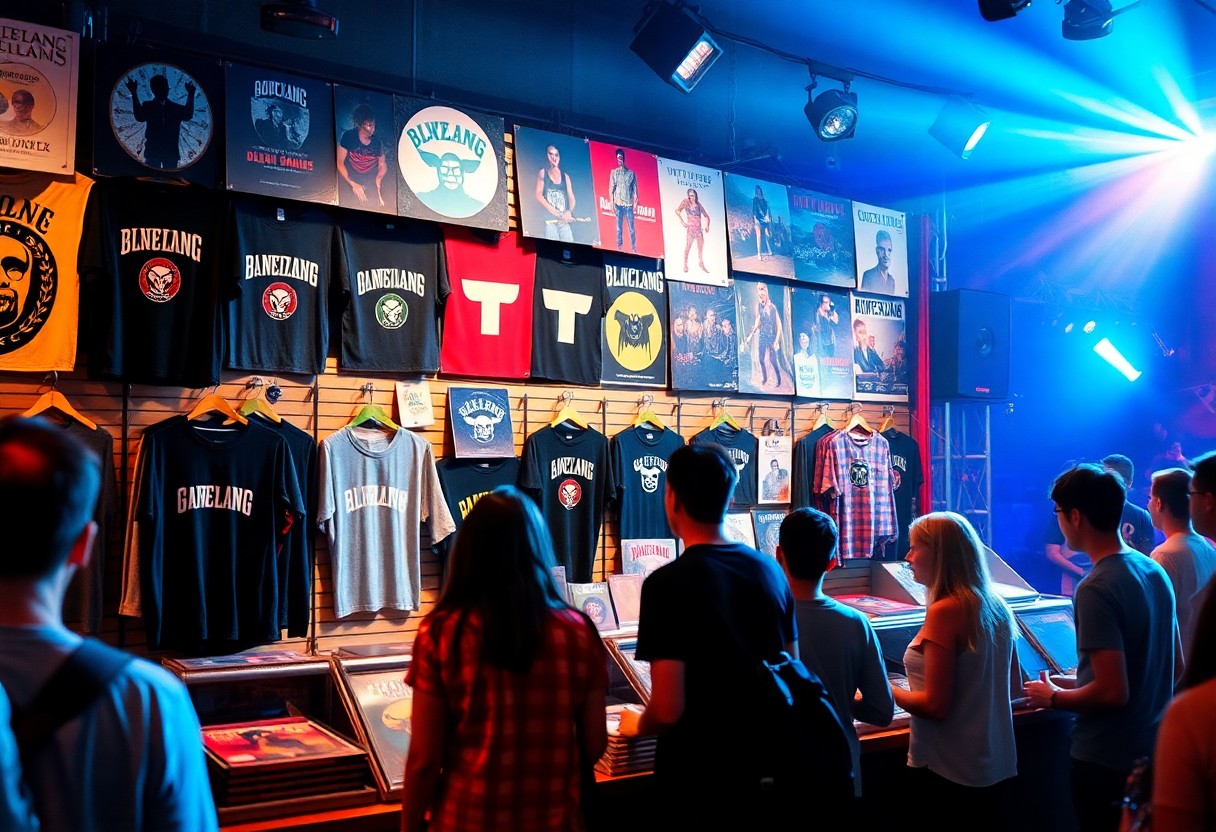You have the opportunity to significantly enhance your band’s revenue through effective merchandising strategies. By creating unique and appealing merchandise, you not only provide your fans with a tangible way to support your music, but also open avenues for passive income that can sustain your artistic journey. Emphasizing quality and creativity in your products can set you apart in a competitive market, while clever marketing techniques can amplify your sales. This post will guide you through the vitals of merchandising, ensuring you maximize your potential and tap into new revenue streams.
Key Takeaways:
- Develop a unique brand identity that resonates with your target audience, incorporating elements that reflect your music style and personal message.
- Choose quality merchandise that aligns with your brand, focusing on items that fans will appreciate and use, such as clothing, accessories, and limited edition collectibles.
- Leverage online platforms for e-commerce, ensuring your merchandise is accessible to a wider audience alongside your music downloads and streaming services.
- Utilize social media to promote your merchandise, creating engaging content that showcases your products and highlights fan interactions.
- Offer exclusive merchandise at live shows to enhance the concert experience, providing fans with a tangible connection to the event and your music.
- Consider collaborations with artists or brands to create unique merchandise items that can expand your audience and increase sales opportunities.
- Track sales data and fan feedback to refine your merchandise offerings, adjusting your strategy based on what resonates most with your audience.
Understanding Merchandising Basics
Before plunging into merchandising, it’s necessary to grasp the foundational concepts. Merchandising refers to the process of promoting and selling your band’s products in a way that resonates with your audience. Whether you are an up-and-coming band or an established artist, effective merchandising can significantly impact your revenue streams. Comprehending the basics will help you develop a strong strategy and connect with your fans.
Types of Band Merchandise
Below are various types of merchandise that can help enhance your brand:
| Apparel | T-shirts, hoodies, caps, and more. |
| Accessories | Jewelry, bags, and pins. |
| Music | CDs, vinyl records, and digital downloads. |
| Posters | Artwork and promotional posters. |
| Collectibles | Limited edition items and autographed merch. |
The variety of merchandise options available allows you to cater to different fan preferences.
Target Audience Analysis
Types of audience analysis provide insights into who your fans are and what they may be interested in purchasing. Analyzing your target audience involves demographics, interests, and purchasing behavior. By understanding your audience, you can tailor your merchandise offerings to better align with their preferences, ensuring higher sales and customer satisfaction.
Understanding your target audience is imperative for maximized merchandising success. By conducting thorough analysis, you can identify your fans’ demographics such as age and location, as well as their interests and buying habits. This information enables you to create merchandise that resonates with them, thus enhancing their connection to your brand. Effective marketing strategies are developed through this insightful data, leading to increased revenue and strength in your overall artistic brand. Focus on continuously gathering feedback to adapt and grow your merchandise offerings.
Creating a Merchandise Strategy
Some artists overlook the importance of a well-thought-out merchandise strategy, which can significantly increase your revenue. Start by identifying your target audience, understanding their preferences, and aligning your merchandise offerings accordingly. Consider your brand identity and the message you want to convey through your products. A cohesive strategy helps ensure consistency and strengthens your fan connection.
Product Design and Quality
On the surface, product design and quality may seem secondary; however, they play a pivotal role in your merchandise’s success. Invest time in creating unique designs that resonate with your fans, ensuring they reflect your brand’s essence. Coupled with high-quality materials, this enhances the overall customer experience, encouraging repeat purchases and positive word-of-mouth.
Pricing and Profit Margins
On a practical level, establishing the right pricing and profit margins is vital for your merchandise’s financial health. It’s necessary to strike a balance between affordability for your fans and ensuring a reasonable profit for sustainability.
Considering your production costs, market demand, and fan expectations, aim for a price point that maximizes profit margins while remaining appealing to your audience. Monitor competitors and adjust your prices accordingly. Effective pricing strategies can also create a perception of value around your merchandise, encouraging fans to invest in your brand. Always keep in mind the importance of maintaining quality at any pricing level, as it reflects your commitment to your fans and directly influences their purchasing decisions.
Distribution Channels
All successful band artists understand that effective distribution channels are key to maximizing merchandise sales. By targeting multiple avenues, you can reach broader audiences while optimizing revenue. It’s important to explore different platforms and methods to ensure your merchandise is accessible, creating a lasting connection with your fans.
Online Sales Platforms
Along with traditional sales methods, online sales platforms play a significant role in reaching your audience. Utilizing services like Bandcamp, Shopify, or Etsy enables you to offer a variety of merchandise directly to your fans, no matter where they are in the world. This approach not only broadens your customer base but also fosters meaningful engagement with your supporters.
Live Event Sales
Live events present a dynamic opportunity for merchandise sales. The energy of shows creates an environment where fans are eager to purchase items that enhance their concert experience and act as souvenirs.
But, you must carefully plan your live event sales strategy to maximize profits. Ensure you have a well-displayed booth with a variety of items, and be prepared with sufficient inventory to meet the demand. Engaging with your fans while promoting your merchandise creates a positive atmosphere, but don’t overlook the challenges of theft and stock management that may arise. By being proactive, you can increase your overall sales and create memorable experiences for your fans.
Building Your Brand Through Merchandise
Unlike solely relying on music sales, effective merchandising allows you to create a lasting brand identity that resonates with your audience. Merchandise is a powerful tool, transforming your artwork and music into tangible products that fans can cherish, thus fostering a deeper connection with your brand. By strategically incorporating your unique style into merchandise, you can enhance your visibility and build a loyal fanbase that extends beyond just your music.
Visual Identity and Consistency
About your visual identity, it’s vital to maintain consistency across all merchandise. This means using your distinct colors, logos, and design elements in a way that reflects your music and persona. A strong, consistent visual identity not only reinforces your brand but also makes your merchandise instantly recognizable, ensuring that fans identify with your products and feel a connection to your artistry.
Limited Edition Items
Consistency in offering limited edition items can create excitement and drive demand among your audience. Indeed, offering exclusive merchandise can encourage fans to purchase quickly, knowing that item availability is scarce. This scarcity can elevate the perceived value of your products, making them more desirable. To maximize impact, release these items during significant moments, such as album launches or special anniversaries, while continuing to align with your brand’s overall aesthetic. Balancing scarcity and thoughtful branding will ensure that your limited editions contribute positively to your overall merchandise strategy.
Marketing Your Merchandise
Now that you have a fantastic selection of merchandise, it’s time to focus on effective strategies to get your products in front of your audience. Leveraging various marketing channels will not only increase visibility but also significantly boost your sales. By implementing a well-rounded marketing approach, including social media and email campaigns, you can connect with fans and encourage them to support you through merchandise purchases.
Social Media Promotion
For reaching your audience, social media platforms are invaluable. Engaging with your fans through polls, sneak peeks of new items, and live sales can create buzz around your merchandise. Consistency in posting, utilizing influencer partnerships, and interactive stories will help to drive traffic to your merchandise shop, turning followers into buyers.
Email Marketing Campaigns
Before launching an email marketing campaign, it’s important to build an email list of dedicated fans and customers. This list allows you to communicate directly with your supporters, offering exclusive promotions and updates on new products. Crafting engaging newsletters helps keep your merchandise top-of-mind, encouraging ongoing purchases.
Also, consider segmenting your email list to tailor your messages to different fan groups. This personalization can significantly increase engagement rates. In your campaigns, highlight limited-time offers and exclusive merchandise to create urgency. Don’t neglect the significance of appealing visuals and strong calls to action within your emails, as these elements can lead to higher conversion rates. Ensuring compliance with email marketing regulations will also foster trust with your audience, ultimately enhancing your brand reputation.
Inventory Management
Not managing your inventory effectively can lead to lost sales and increased costs. Understanding how to maintain an optimal stock level of your merchandise is vital for a band artist like you. By implementing the right inventory management practices, you can maximize your revenue while minimizing waste, ensuring that your fans always have access to your products.
Stock Control Systems
The right stock control system allows you to efficiently track your merchandise levels, sales trends, and reorder points. Utilizing software solutions can streamline your inventory processes, help you avoid overstock and stockouts, and ultimately enhance your ability to respond swiftly to demand fluctuations.
Supplier Relationships
Systems that manage supplier relationships are fundamental to maintaining quality and sustainability in your inventory. Building strong connections with your suppliers enables you to negotiate better terms and ensure timely deliveries.
To create effective supplier relationships, you should focus on consistent communication and establishing clear expectations. Maintaining a positive rapport with your suppliers can lead to favorable pricing, faster turnaround times, and exclusive access to limited edition products. Additionally, being clear about your needs allows you to lead more effective negotiations, ensuring that both you and your suppliers benefit from the partnership. Ultimately, a strong supplier network is vital for keeping your merchandise appealing and well-stocked for your fans.
To wrap up
Now that you understand the importance of merchandising for band artists, you can take actionable steps to boost your revenue. By diversifying your merchandise offerings, engaging with your audience effectively, and leveraging online platforms, you can create a sustainable income stream. Focus on quality, creativity, and brand identity to ensure that your merchandise resonates with fans. This not only enhances your financial success but also strengthens your connection with your audience, turning casual listeners into loyal supporters. Your merchandise can be more than just products; it can be a key part of your brand’s narrative.
FAQ
Q: What types of merchandise are best for band artists?
A: Popular merchandise options for band artists include T-shirts, hoodies, caps, and posters reflecting the band’s branding and album art. Unique items like vinyl records, tote bags, and even limited edition collectibles can also attract fans. It’s important to create a range of products to appeal to different demographics within your fan base.
Q: How can band artists effectively design their merchandise?
A: Effective merchandise design should align with the band’s image and aesthetic. Collaborating with graphic designers who understand your vision can enhance the appeal. Consider incorporating album artwork, album titles, song lyrics, or quotes that resonate with your music and audience. Quality designs that reflect the band’s identity will resonate more with fans.
Q: What are the best strategies for selling merchandise at live events?
A: Selling merchandise at live events can be optimized by positioning a merch booth in a high-traffic area. Offer exclusive items that are only available at the event to create urgency. Engaging with fans directly and promoting a bundle deal or discount can entice more purchases. Additionally, having a mobile payment option can streamline transactions.
Q: How can social media be utilized to promote merchandise?
A: Social media platforms are effective for showcasing merchandise. High-quality images, videos, and stories can highlight new products and create buzz. Engaging with fans through giveaways or behind-the-scenes content can also motivate purchases. Regularly posting about merchandise on platforms like Instagram, Facebook, and TikTok can help keep it at the forefront of fans’ minds.
Q: What are some tips for pricing merchandise appropriately?
A: Pricing merchandise requires consideration of production costs, market research, and perceived value. Research similar products from other artists to gauge pricing trends. It’s beneficial to factor in costs such as manufacturing, shipping, and selling fees. Offering tiered pricing for different merchandise levels can also cater to various budget ranges within your fan base.









